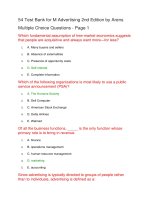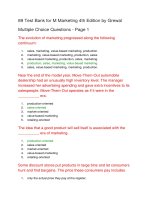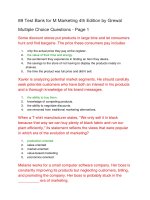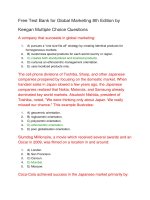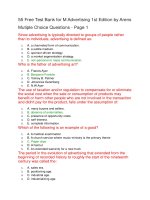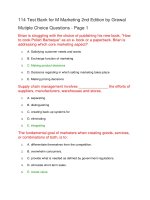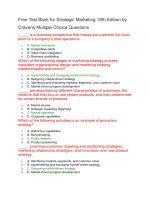114 test bank for m marketing 2nd edition by grewal
Bạn đang xem bản rút gọn của tài liệu. Xem và tải ngay bản đầy đủ của tài liệu tại đây (188.98 KB, 38 trang )
114 Test Bank for M Marketing 2nd Edition by Grewal
Mutiple Choice Questions - Page 1
Brian is struggling with the choice of publishing his new book, "How
to cook Polish Barbeque" as an e- book or a paperback. Brian is
addressing which core marketing aspect?
1.
A. Satisfying customer needs and wants
2.
B. Exchange function of marketing
3.
C. Making product decisions
4.
D. Decisions regarding in which setting marketing takes place
5.
E. Making pricing decisions
Supply chain management involves ______________ the efforts of
suppliers, manufacturers, warehouses and stores.
1.
A. separating
2.
B. distinguishing
3.
C. creating back-up systems for
4.
D. eliminating
5.
E. integrating
The fundamental goal of marketers when creating goods, services,
or combinations of both, is to:
1.
A. differentiate themselves from the competition.
2.
B. overwhelm consumers.
3.
C. provide what is needed as defined by government regulations.
4.
D. stimulate short-term sales.
5.
E. create value.
Whenever Jami calls on his building contractor customers he asks if
they are having any problems. In doing so, Jami is addressing
which of the following core aspects of marketing?
1.
A. Satisfying customer needs and wants
2.
B. Exchange function of marketing
3.
C. Product, place, promotion, and price decisions
4.
D. Decisions regarding in which setting marketing takes place
5.
E. Creating value objective of marketing
Marketing efforts designed to get the product or service to the right
customer, when that customer wants it, are called:
1.
A. supply chain management.
2.
B. situational distribution efficiency.
3.
C. wholesaling.
4.
D. marketing myopia.
5.
E. endless chain marketing.
The importance of supply chain management is often overlooked
because:
1.
A. it is considered boring.
2.
B. pricing strategy is more fun.
3.
C. companies do not want organization members to understand the problems
involved.
4.
D. many of the activities take place behind the scenes.
5.
E. it is more properly an operations management issue.
________________ is communication by a marketer that informs,
persuades, and reminds potential customers.
1.
A. Pricing
2.
B. Promotion
3.
C. Placement
4.
D. Product value creation
5.
E. Pork barreling
Fiona has developed a new software application that automatically
reconfigures accounting information based on the standards used in
each country. Her product is superior to anything that exists on the
market. Which of the following decisions is NOT one of the key
marketing decisions she will have to make?
1.
A. How the software will be promoted?
2.
B. What price to charge?
3.
C. What distribution channels to use?
4.
D. Where to introduce the software?
5.
E. How many software products typically fail?
The four Ps comprise the _______________, which is the
controllable set of activities that the firm uses to respond to the
wants of its target markets.
1.
A. elements of practice
2.
B. internal operation focus
3.
C. needs response mechanism
4.
D. marketing mix
5.
E. functional marketing discipline
Four Winds Art Gallery recently began offering appraisals of
customers' art collections. Four Winds is:
1.
A. expanding from offering just service to offering goods.
2.
B. implementing a market segmentation strategy.
3.
C. capturing value through multiple pricing strategies.
4.
D. expanding from offering just goods to offering services.
5.
E. increasing customer value through inflated appraisal evaluations.
When referring to "exchange," marketers are focusing on:
1.
A. location where products and services are traded.
2.
B. price charged adjusted for currency exchange rates.
3.
C. creating value.
4.
D. promotional offers designed to stimulate barter.
5.
E. the trading of things of value.
The goal of promotion is to inform, persuade and remind
____________ about a product or service.
1.
A. competitors
2.
B. distributors
3.
C. sales representatives
4.
D. potential buyers
5.
E. television - including cable - networks
Julia is considering a career in marketing. She is concerned about
the image of marketers as fast-talking, high-pressure people. When
reading about the core aspects of marketing, Julia is relieved to see
that in marketing:
1.
A. all parties to an exchange should be satisfied.
2.
B. promotion is foremost, followed by pricing decisions.
3.
C. decisions are made regarding how a product is designed.
4.
D. customers are not needed until the product is ready for sale.
5.
E. distribution is controlled by customers.
The owner of The House Doctor, a home repair business, often
helped potential customers evaluate alternative ways to fix
problems. Since he got paid for materials and labor when doing
repairs, the House Doctor:
1.
A. was only offering a product.
2.
B. was offering only a service.
3.
C. provided both a service and a product.
4.
D. was primarily a marketer of ideas.
5.
E. focused on supply chain management.
Which of the following is NOT true about marketing ideas?
1.
2.
A. Opinions, philosophies, intellectual concepts and even thoughts can be
effectively marketed.
B. Marketing ideas does not involve real exchange of value.
3.
C. Ideas can be "purchased" by convincing someone to change his or her
behavior.
4.
D. Marketing can be directed toward primary and secondary targets to
increase knowledge and change behavior.
5.
E. Value can be created through changing behaviors.
In most supermarkets there are numerous almost identical
products, some with brand names and others with store or generic
labels. In terms of creating product value for the consumer, which of
the following does not create a difference in value between branded
and generic products?
1.
A. Brand image
2.
B. Intrinsic ingredients
3.
C. Price
4.
D. Customer relationship between the manufacture and the store manager
5.
E. How it is sold in the store
Local radio advertising often includes ads for competing
automobiles dealerships using actors trying to create a sense of
excitement and urgency among consumers, even if the ads annoy
many listeners. These ads are attempting to achieve the
promotional goal of _____________ potential buyers.
1.
A. informing
2.
B. persuading
3.
C. reminding
4.
D. entertaining
5.
E. overwhelming
Marketers must determine the price of a product carefully on the
basis of the potential buyer's belief about:
1.
A. its value.
2.
B. the environment.
3.
C. advertising.
4.
D. monetary policy.
5.
E. external stimuli.
The time involved in making a purchasing decision, the actual
money to be spent, the effort involved, and any sacrifice the buy
makes are all elements of:
1.
A. promotion parameters.
2.
B. distribution or place drivers.
3.
C. core product differentiators.
4.
D. processes consumers must follow.
5.
E. price.
Marketing traditionally has been divided into a set of four
interrelated decisions known as the marketing mix, or four Ps,
including all of the following EXCEPT:
1.
A. product.
2.
B. place.
3.
C. performance.
4.
D. promotion.
5.
E. price.
Smart marketers recognize that when exchanges take place with
their customers, whether in person or electronically, it is an
opportunity to:
1.
A. demonstrate the limitations of competitors' offerings.
2.
B. gather information.
3.
C. offer discounts.
4.
D. investigate alternative distribution system stimuli.
5.
E. design new product offerings for other market segments.
Whenever Valerie has a new massage therapy customer, she asks
the person if they want to be on her e- mail distribution list. In the
process, in addition to exchanging her massage therapy service for
payment, Valerie is gathering:
1.
A. information.
2.
B. promotional effective analysis.
3.
C. pricing data.
4.
D. value.
5.
E. names to sell to list brokers.
Which of the following activities does NOT involve marketing?
1.
A. Purchasing gasoline
2.
B. Attending marketing class
3.
C. Downloading music
4.
D. Deciding how many hours to sleep
5.
E. Selling a CD on eBay
Delivering the value proposition is also known as:
1.
A. endless chain marketing.
2.
B. situational distribution efficiency.
3.
C. wholesaling.
4.
D. marketing myopia.
5.
E. supply chain management.
Henriette offers financial counseling and management on a fee-only
basis. She has found that different customers are willing to pay
different rates for her service. Henriette recognizes that her pricing
decisions primarily depend on:
1.
A. regulations determining the fees financial advisors can charge.
2.
B. changes in technology allowing consumers to manage their own affairs.
3.
C. how much customers are willing to pay and are satisfied with their
purchase.
4.
D. changes in the economy creating recessions or periods of expansion.
5.
E. how much effort she has to expend in assisting her clients.
When considering career choices in marketing, many students
overlook supply chain management because:
1.
A. it is considered too quantitative.
2.
B. promotion strategy is more fun.
3.
C. companies do not want organization members to understand the problems
involved.
4.
D. it only takes place in large, urban areas.
5.
E. many of the activities take place behind the scenes.
UPS, FedEx, and DHL all support other companies'
_______________ marketing goal.
1.
A. supply chain management
2.
B. pricing
3.
C. product value
4.
D. promotional effectiveness
5.
E. marketing research
UPS requires their delivery people to wear uniforms and wash their
trucks nightly so they are always clean. Part of the reason this
service company created these policies is because they recognize:
1.
A. consumers like delivery people who are wearing earth-toned clothing.
2.
B. their competitors could not do this.
3.
C. consumers' image of the benefits they receive are tied to their image of the
producer.
4.
D. the goods UPS sells are easily replicated.
5.
E. cleaner trucks improve fuel efficiency.
Marketing includes offering:
1.
A. products.
2.
B. services.
3.
C. ideas.
4.
D. causes.
5.
E. combinations of products, services, ideas, and causes.
The basic difference between a good and a service is a good:
1.
A. provides intangible benefits.
2.
B. can be physically touched.
3.
C. is always less expensive than a corresponding service.
4.
D. generates greater interest among consumers.
5.
E. depreciates more rapidly in the minds of consumers.
Marketers involved in supply chain management are constantly
balancing the:
1.
A. goal of promotional effectiveness against ethical advertising standards.
2.
B. problem of price maximization against cost efficiency.
3.
C. goal of minimizing costs against satisfying the service levels customers
expect.
4.
D. desire to achieve against the need for a stabile source of supply.
5.
E. goal of efficiency against the goal of profit minimization.
Marketing involves all of the following EXCEPT:
1.
A. exchange.
2.
B. satisfying customer needs and wants.
3.
C. creating value.
4.
D. efforts by individuals and organizations.
5.
E. production scheduling.
Some discount stores put products in large bins and let consumers
hunt and find bargains. Part of the price these consumers pay is:
1.
A. cost of providing the bins.
2.
B. the value of their time and energy.
3.
C. excitement they experience in finding an item they desire.
4.
5.
D. the savings to the store of not having to display the products neatly on
shelves.
E. the savings to the store of not having to hire retail sales personnel.
The marketing goal of getting the "right quantities to the right
locations, at the right time" is:
1.
A. communicating the value proposition.
2.
B. supply chain management.
3.
C. creating value.
4.
D. capturing value.
5.
E. price and performance management.
Which of the following is a core aspect of marketing?
1.
A. Satisfying the firm's wants and needs
2.
B. Creating universal coverage
3.
C. Instilling self-sufficiency
4.
D. Making product, place, promotion, and price decisions
5.
E. Working with the creative people in ad agencies
Every Christmas season, Anheuser-Busch runs television ads
featuring Clydesdale horses in a winter scene. These ads focus on
the promotional goal of __________ consumers about the
company's brand.
1.
A. informing
2.
B. persuading
3.
C. reminding
4.
D. entertaining
5.
E. creating an emotional bond with
Ellen's firm has been installing home entertainment systems for ten
years. In a new approach, she has started selling a line of imported
speakers that offer superior value to her customers when they
upgrade their systems. Ellen should focus her marketing efforts on:
1.
A. the service she provides to customers.
2.
B. the new merchandise.
3.
C. a combination of the services and the merchandise.
4.
5.
D. the speakers until they become profitable than return her focus to the core
of her business - the installation.
E. economic trends in the country where the speakers are manufactured.
Yesenia, the new university course scheduling manager, is
struggling with adjustments to the fall schedule. She is trying to
determine how to offer what the students need at the times students
need them. Yesenia is struggling with the marketing function of:
1.
A. communicating the value proposition.
2.
B. supply chain management.
3.
C. creating value.
4.
D. capturing value.
5.
E. tormenting students.
Which of the following is NOT one of the key questions which must
be asked when making marketing decisions?
1.
A. How is the product to be designed?
2.
B. How much should the product cost?
3.
C. Where should the product be promoted?
4.
D. How will the product be delivered to the customer?
5.
E. Whose responsibility is it to ensure customer service representatives
handle returned merchandise properly?
114 Free Test Bank for M Marketing 2nd Edition by
Grewal Mutiple Choice Questions - Page 2
Value is:
1.
A. the lowest cost option.
2.
B. represented by brand names.
3.
C. the highest priced alternative.
4.
D. everyday low prices.
5.
E. what you get for what you give.
Many U.S. companies first discovered marketing during the
_________ era.
1.
A. production
2.
B. sales
3.
C. marketing
4.
D. value-based marketing
5.
E. pioneering
The "Got Milk" advertising campaign was designed to help market
a(n):
1.
A. individual.
2.
B. firm.
3.
C. industry.
4.
D. organization.
5.
E. nutritional cause.
The evolution of marketing progressed along the continuum:
1.
A. sales, marketing, value-based marketing, production.
2.
B. marketing, value-based marketing, production, sales.
3.
C. value-based marketing, production, sales, marketing.
4.
D. production, sales, marketing, value-based marketing.
5.
E. sales, value-based marketing, marketing, production.
To become a better value driven organization, the manager of
BestBulk clothing store directed her staff to _________________
customers, competitors, complaints and inventories.
1.
A. second-guess the needs of
2.
B. avoid being overwhelmed by
3.
C. place organizational priorities above those of
4.
D. develop their own capacities to control
5.
E. share information about
In the past, manufacturer's representatives did not have up-tominute data about the products they were selling. Today,
manufacturer's representatives are often provided Intranet access
to inventory data for the companies they represent. Intranet
systems allow companies to become more value driven through:
1.
A. sharing information across the organization.
2.
B. balancing customers' benefits and costs.
3.
C. evaluating strategic competitive partnerships.
4.
D. building relationships with government regulators of marketing institutions.
5.
E. demonstrations of technical competencies.
Near the end of the model year, Move-Them-Out automobile
dealership had an unusually high inventory level. The manager
increased her advertising spending and gave extra incentives to its
salespeople. Move- Them-Out operates as if it were in the
__________ era.
1.
A. production
2.
B. sales
3.
C. marketing-oriented
4.
D. value-based
5.
E. surplus commodity
The idea that a good product will sell itself is associated with the
_______________ era of marketing.
1.
A. production
2.
B. sales
3.
C. marketing
4.
D. value-based marketing
5.
E. self-evident
By promoting perfume based on youth, style, and sex appeal,
Calvin Klein is attempting to:
1.
A. influence social norms regarding sexuality.
2.
B. increase price resistance.
3.
C. stimulate supply chain management cooperation.
4.
D. increase the perceived value of their products.
5.
E. avoid interference from the Federal Trade Commission.
The traditional marketing channel through which consumers find
and purchase goods and services is known as:
1.
A. B2B.
2.
B. C2C.
3.
C. D2C.
4.
D. C2D.
5.
E. B2C.
Effective promotion enhances a product's or service's:
1.
A. supply chain management system.
2.
B. wholesaling capabilities.
3.
C. perceived value.
4.
D. cost.
5.
E. retailing potential.
The prevailing marketing strategy of the ______________ era was
to find customers for inventories that went unsold.
1.
A. production
2.
B. sales
3.
C. marketing
4.
D. value-based marketing
5.
E. pioneering
_________________ depends on knowing what customer perceive
as key benefits and balancing them with reasonable costs while
looking at quality from the customer's perspective.
1.
A. Supply chain management
2.
B. Promotion
3.
C. Effective advertising
4.
D. Tactical pricing
5.
E. Value-based marketing
During the ______________ era, firms had excess capacity and
used personal selling and advertising to generate customers.
1.
A. production
2.
B. sales
3.
C. marketing
4.
D. value-based marketing
5.
E. pioneering
The advent of auction sites like eBay has increased
_______________ marketing.
1.
A. B2B
2.
B. C2C
3.
C. D2C
4.
D. C2D
5.
E. B2C
Retailers accumulate merchandise from producers in large amounts
and sell to consumers in smaller amounts. Retailers function as:
1.
A. market intermediaries.
2.
B. monopolists.
3.
C. regulators of consumer demand.
4.
D. wholesaling specialists.
5.
E. intermediate promoters.
As owner of a retail franchise food store, Mary Gray coordinates her
purchasing with specials advertised nationally throughout the
franchise system. One Monday she was surprised to find customers
asking for specials that she did not know about in advance. The
franchise company failed the value driven principle of:
1.
A. sharing information across the organization.
2.
B. balancing customers' benefits and costs.
3.
C. evaluating strategic competitive partnerships.
4.
D. building relationships with customers.
5.
E. avoiding major announcements over high-traffic weekends.
Yolanda is the new restaurant manager in a major hotel. When
considering changes in the restaurant to improve benefits to
customers, Yolanda will likely attempt to either provide the same
quality at a lower cost or:
1.
A. improve products and services at the same cost.
2.
B. increase prices to increase revenue.
3.
C. offset higher hotel rates with lower restaurant prices.
4.
D. reduce customer benefit expectations through reduced service.
5.
E. cut back slightly on portion sizes and reduce the number of wait staff
through attrition.
When preparing for and engaging in a job interview, potential
employees engage in marketing most closely associated with
_______________ marketing.
1.
A. consumer to business
2.
B. business to business
3.
C. consumer to consumer
4.
D. business to consumer
5.
E. professional services
In delivering value, marketing firms attempt to find the most
desirable balance between:
1.
A. the need for value and the perception of value.
2.
B. explicit versus implicit value.
3.
C. providing benefits to customers and keeping costs down.
4.
D. the desire to satisfy customers and the need to keep customers from
running the company.
5.
E. the need for product improvement and the need for advertising.
Fiona, the new manager of Common Ground Coffee House, is
assessing vendor performance, customer complaints, advertising
effectiveness, and all aspects of her business. Fiona recognizes
value-based marketing:
1.
A. is based primarily on consumer perceptions.
2.
B. offers insights into competitor's actions.
3.
C. should be at the core of every firm's functions.
4.
D. depends on constantly changing global pressures.
5.
E. forces consumers to constantly change their perceptions.
In 2006, the film Supersize Me provided a critical view of
McDonalds Company and their products. The company was caught
off guard and had to quickly develop a response. In terms of valuebased marketing, McDonalds faced the potential problem of:
1.
A. consumer perceptions change quickly.
2.
B. competitors constantly enter markets.
3.
C. global pressures continually reshape market opportunities.
4.
D. marketers' understanding of consumers is complete.
5.
E. product placement in films.
Many universities provide physical or electronic bulletin boards to
facilitate ride-sharing and exchange of used books among students.
These bulletin boards increase _________ marketing.
1.
A. B2C
2.
B. B2B
3.
C. A2C
4.
D. C2C
5.
E. underground
During the marketing era:
1.
A. a good product would sell itself.
2.
B. the customer was king.
3.
C. marketing was more important than production.
4.
D. advertising and personal selling will make the sale.
5.
E. firms focused on value.
Adding Value 1.1: My M&Ms discusses a market approach similar
to that used by companies like Nike that allows customers to
custom-design the products. Marketers offering services also bring
customers into the design process to create custom approaches.
This is known as:
1.
A. vanity product development.
2.
B. value customization.
3.
C. premium design.
4.
D. value co-creation.
5.
E. extreme customer service.
Some customers will seek to get a lot of merchandise for a small
amount of money. In marketing, this is known as:
1.
A. the marketing paradox.
2.
B. the outer limits of pricing.
3.
C. customers seeking value.
4.
D. profit pricing.
5.
E. value variation.
Henry Ford's statement, "Customers can have any color they want
so long as it's black," typified the ____________ era of marketing.
1.
A. production
2.
B. sales
3.
C. marketing
4.
D. value-based marketing
5.
E. pioneering
Janine has a new clothing design she would like to market. She
knows creating and delivering value to consumers is difficult and
has seen designers' successful products have been quickly
replicated. For Janine, the major problem she faces in creating and
delivering value is most likely to be:
1.
A. consumer perceptions change quickly.
2.
B. competitors constantly enter markets.
3.
C. global pressures continually reshape market opportunities.
4.
D. marketers' understanding of consumers is complete.
5.
E. shortages in popular fabrics and materials customers will want.
The discussion of Zappos in the Power of Internet Marketing 1.1
demonstrates:
1.
A. How increased promotion on the internet can be used to create value.
2.
B. Centralizing fulfillment operations is superior for a marketer because of the
enhanced inventory control.
3.
C. How the third P - Place - is becoming irrelevant is the emerging world of
internet commerce.
4.
D. How consumers are not particularly concerned about delivery and
availability as long as the product is stylish.
5.
E. How supply chain management is a critical component of marketing that
creates value for customers.
As use of the Internet took off, car manufacturers were tempted to
sell directly to consumers but decided to maintain their existing
dealer networks. The car manufacturers considered switching from
__________ to ____________ marketing.
1.
A. B2C; B2B
2.
B. B2C; A2Z
3.
C. B2B; B2C
4.
D. B2B; EDF
5.
E. ABC; XYZ
During the ____________ era manufacturers and retailers
recognized they needed to give their customers greater value than
their competitors did.
1.
A. production
2.
B. sales
3.
C. marketing
4.
D. value-based marketing
5.
E. pioneering
Bill operates a bookstore with a special focus on technical books
and a modest range of general interest books. He knows his
customers weigh the costs versus the benefits associated with the
different options available including large chains and Internet
options. He decides which books and periodicals to carry and what
prices to charge based on the way his customers think. Bill
operates in the _________ era of marketing.
1.
A. production
2.
B. sales
3.
C. marketing
4.
D. value-based marketing
5.
E. pioneering
Deborah works for a small manufacturing company. Her boss
founded the company to produce a valve he had invented. While
the valve was revolutionary when it was first made, her boss is
constantly improving their products. Unfortunately, he doesn't pay
the same kind of attention to customers or the internal operations of
the firm. Her boss is probably stuck in the _____________ era of
marketing.
1.
A. production
2.
B. sales
3.
C. marketing
4.
D. value-based marketing
5.
E. pioneering
Christie has just started with a travel agency, and she has been
offering clients and prospective clients a range of pre-packaged
tours. She is concerned, because she is not making the kinds of
commissions she'd like. She has seen that her colleague Peter,
who has been with the agency for quite a while, is having a great
deal of success by working with the clients, taking their suggestions
and building unique tour packages. Peter's approach is based on:
1.
A. extraordinary good luck.
2.
B. premium pricing.
3.
C. his seniority at the firm.
4.
D. special incentives from tour operators.
5.
E. value co-creation.
During the ____________ era manufacturers and retailers began to
focus on what consumers wanted and needed before they
designed, made, or attempted to sell their products.
1.
A. production
2.
B. sales
3.
C. marketing
4.
D. value-based marketing
5.
E. pioneering
Serena studies her customer profiles, market research data,
complaints, and other information attempting to better understand
what her customers want. Serena operates in the __________ era
of marketing.
1.
A. production
2.
B. sales
3.
C. marketing
4.
D. value-based marketing
5.
E. pioneering
To become a more value driven organization, Pokrah University is
holding coffee-hour discussions with its students and surveying its
graduates regarding students' educational needs and desires.
Pokrah University is becoming more value driven by:
1.
A. sharing information across their organization.
2.
B. balancing their customers' benefits and costs.
3.
C. evaluating strategic competitive partnerships.
4.
D. building relationships with customers.
5.
E. emulating practices in private industry.
114 Free Test Bank for M Marketing 2nd Edition by
Grewal Mutiple Choice Questions - Page 3
Greenbelt Construction has been a successful small home-building
firm for years. The owner pays subcontractors slightly more than
the going rate, reducing the company's gross margin. Greenbelt
rarely changes subcontractors, has relatively few complaints from
buyers, and quick responses from subcontractors when they do
have problems. Greenbelt is engaged in:
1.
A. traditional transactional orientation.
2.
B. C2C value driven marketing.
3.
C. effective supply chain management.
4.
D. marketing mix maximization.
5.
E. profit optimization.
Beth is very creative, who has been able to put herself through
college writing and performing songs. Steven is a wizard with
statistics, though he isn't sure what to do with his talent. Peter is
fanatic about project management and has taken a leadership role
in every group project in school. Which of these graduating seniors
could consider a career in marketing?
1.
A. Beth only
2.
B. Beth and Steven
3.
C. Beth and Peter
4.
D. Steven and Peter
5.
E. Beth, Steven and Peter
Imagine a country where an anti-marketing dictator orders all
marketing efforts to be stopped. Producers are still allowed to
produce, and consumers are allowed to consume but no marketing
is allowed. In such a situation:
1.
A. consumers will have a constant stream of innovations to choose from.
2.
B. producers will easily know the needs of consumers through central
planning.
3.
C. consumers will know the value of different producer's offerings through
enhanced communications.
4.
D. producers will know where to ship their products and when through
enhanced logistics.
5.
E. there will be no advertising making it difficult to learn about producer's
offerings.

